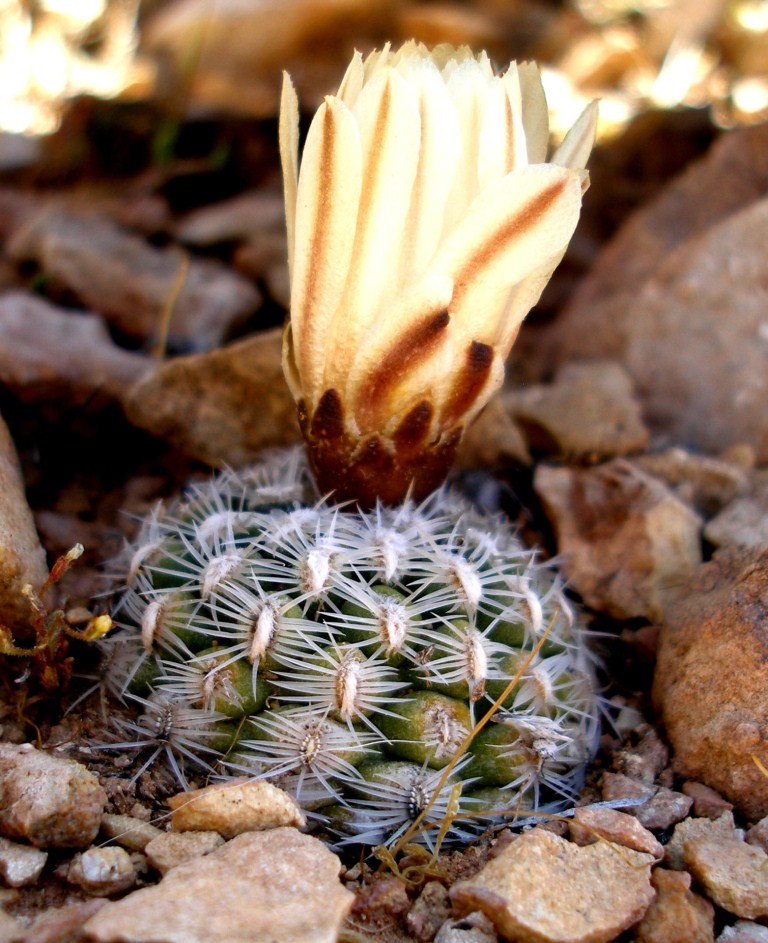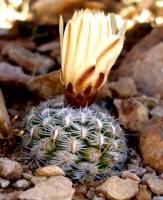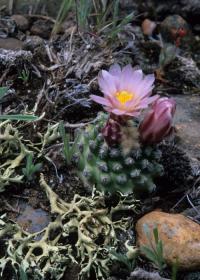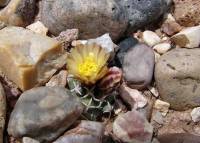Plants unbranched or few branched, deep-seated in substrate or rising 1 -15 cm above substrate. Roots appearing as taproots at soil surface, branching, and ultimately diffuse. Stems unsegmented, green or gray-green, obconic-cylindric to spheric or depressed-spheric, 2-15 × 1-15 cm; tubercles distinct, not confluent into ribs, pyramidal, conic, truncate-conic, cylindroid, or mammillate, 2-10 mm; areoles circular, oval, pyriform, or elliptic, spiny and short or long woolly or glabrate; areolar glands absent; cortex and pith usually mucilaginous. Spines 3-45, reddish tan, pink, gray, or white, needle-shaped or awl-shaped to hairlike, 6-30 × 0.3-1 mm, smooth and hard, less often corky or spongy and soft, finely puberulent to glabrous; radial spines 3-35 per areole, spreading, erect, recurved, or somewhat pectinate, straight or irregularly curved, 1-32 mm; central spines 0-12, straight or curved upward, needlelike, hairlike, or corky, terete to flat. Flowers diurnal, borne at adaxial margins of areoles at stem apex, funnelform, 1-4 × 1-2.5 cm; outer tepals greenish or purple midstripes, pink or yellow margins, 9-25 × 3-9 mm, margins fringed, denticulate, or entire; inner tepals yellow, peach, pink, magenta, cream, or white, 4-15 × 3-7 mm, margins entire to fimbriate; ovary smooth, scaleless to few scaled, spineless; stigma lobes 5-9, yellow to green, 0.7-1.5 mm. Fruits dehiscent along 1 vertical suture, green or greenish yellow, often turning reddish brown, thin walled, cylindric, spheric or turbinate, 4-15 × 3-11 mm, becoming dry at maturity, smooth, scaleless or with few broad, thin scales; pulp greenish to white, scant; floral remnant deciduous. Seeds brown, black or gray, irregularly or obliquely obovoid or pyriform, 1.5-5 × 1-3.5 × 1-1.5 mm, papillate, sometimes also rugose, shiny; testa cells convex. x = 11.
Pediocactus is unified by its unusual fruit dehiscence and deciduous floral remnant. In other traits it is remarkably diverse. As a result, the nine species have historically been divided into as many as five genera. Chloroplast DNA sequences (R. Nyffeler 2002; C. A. Butterworth et al. 2002; J. M. Porter et al. unpublished) provide strong support for the monophyly of Pediocactus. Moreover, the traditional association of Pediocactus and Sclerocactus is refuted. Pediocactus is inferred to be more closely related to Glandulicactus, Turbinicarpus, and Ariocarpus, than to Sclerocactus, by these studies.
PLANT: Stem succulents from freely branching primary and secondary roots.
STEMS: solitary or clustered, 3-25 cm long, 2-11.5 cm diameter, subglobose to ovoid, sometimes depressed apically, to elongate-cylindrical; tubercles 2-12 mm long, 2-11 mm in diameter, not forming distinct ribs.
SPINES: more or less obscuring the stem; central spines 0-9, 0.5-5.3 cm long, up to 3 mm wide at the base, white, pale gray, or reddish-brown to brownish-black, spreading, straight, or curved upward, needle-like or corky; radial spines 3-25, 0.2-2.1 cm long, to 1 mm in diameter, white to pale gray or yellowish-tan.
FLOWERS: at stem apex, 1.2-3 cm long, 1-2.5 cm wide; inner tepals yellow, pink, magenta, cream or white, mostly with paler midstripes than on the outer tepals, oblanceolate, obovate-oblanceolate or oblong-cuneate, 0.4-1.5 cm long, 3-7 mm broad, the margins entire or minutely denticulate; stamens yellow or cream; stigma lobes 5-10, yellow or green.
FRUITS: green or greenish-yellow, often turning reddish-brown, dry, naked or with a few scales, smooth, cylindrical to globular or mostly top-shaped with a constricted base and a slightly convex apex, 0.6-1.5 cm long, 0.5-1.1 cm wide, dehiscing by a vertical slit along one side.
SEEDS: dark brown or gray to black, papillate, often rugose, 2-5 mm long, 1.5-3.5 mm wide, the hilum obovate or elliptic
NOTES: Species 8 in the sw U.S. Delimitation of genus is debated: here to include Utahia Britt. & J. N. Rose, Navajoa Croizat, Pilocanthus B. W. Benson & Backeb. and Pediocactella A. B. Doweld, but is distinct from Sclerocactus Britt. & J. N. Rose. (Greek: pedio = plain referring to habitat and kaktos = a spiny plant). Heil, K. D., B. Armstrong, and D. Schleser. 1981. Cact. Succ. J. (Los Angeles) 53:17-39. Hochstätter, F. 1995. The Genera Pediocactus, Navajoa, Toumeya, Revised. Titisee-Neustat, Netherlands. The status of Pediocactus peeblesianus var. mianus L. D. Benson, is uncertain. It is known only from the type locality near Prescott. Benson (1982) suggests that the holotype is an immature Echinocereus fendleri specimen.
REFERENCES: Heil, Kenneth D., and Mark J. Porter. 2001. Cactaceae. J. Ariz. - Nev. Acad. Sci. Volume 33(1)












